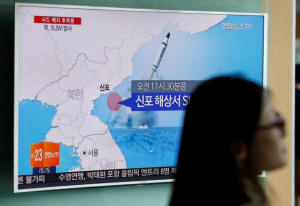|
North Korea fires missile from submarine
but it appears to have failed: South Korea
 Send a link to a friend
Send a link to a friend
 [July 09, 2016]
By Ju-min Park [July 09, 2016]
By Ju-min Park
SEOUL (Reuters) - North Korea fired a
ballistic missile from a submarine on Saturday but it appears to have
failed soon after launch, South Korea's military said.
The launch comes at the end of a week of sharply rising tensions on the
peninsula. It is only a day after the U.S. and South Korea pledged to
deploy an advanced anti-missile system to counter threats from
Pyongyang, and two days after North Korea warned it was planning its
toughest response to what it deemed a "declaration of war" by the United
States.
That followed Washington's blacklisting of the isolated state's leader
Kim Jong Un for alleged human rights abuses.
The South's Office of the Joint Chiefs of Staff said in a statement that
the missile was launched at about 11:30 a.m. Seoul time (0230 GMT) in
waters east of the Korean peninsula.
The missile was likely fired from a submarine as planned but appears to
have failed in the early stage of flight, the Joint Chiefs said.
Neighboring Japan, the United States, and South Korea's military
condemned the missile launch as a flagrant violation of U.N. sanctions.
South Korea's Yonhap news agency said the missile's engine successfully
ignited but the projectile soon exploded in mid-air at a height of about
10 km (6 miles), and covered not more than a few kilometers across the
water.
The South's military declined to confirm those details citing its policy
of not publicly commenting on intelligence matters.

The missile was detected in the sea southeast of the North Korean city
of Sinpo, South Korea's military said. Satellite images indicate
Pyongyang is actively trying to develop its submarine-launched ballistic
missile program in this area, according to experts.
The U.S. Strategic Command, whose mission is to detect and prevent
strategic attacks against the United States and its allies, said it had
detected what it believed was a KN-11 submarine-launched ballistic
missile (SLBM).
It was fired from North Korea's east coast port of Sinpo and then fell
into the sea between there and Japan, the command said in a statement.
ABE CONDEMNS
Reclusive North Korea and the rich, democratic South are technically
still at war because their 1950-53 conflict ended in an armistice, not a
peace treaty. The North regularly threatens to destroy the Japan, South
Korea and the South's main ally, the United States.
The missile launch is a "clear challenge to U.N. Security Council
resolutions," Japanese Prime Minister Shinzo Abe said on Saturday,
according to Kyodo news agency.
"We should strongly condemn the launch by working with the international
community," Abe told reporters.
Abe said the launch did not gravely affect Japan's national security.
The U.S. said it was monitoring and assessing the situation in close
coordination with its regional allies and partners.
"We strongly condemn North Korea's missile test in violation of UN
Security Council Resolutions, which explicitly prohibit North Korea's
use of ballistic missile technology," said Gabrielle Price, spokeswoman
for the Bureau of East Asian and Pacific Affairs at the U.S. Department
of State.
[to top of second column] |

A passenger walks past a TV screen at a railway station in Seoul,
South Korea, broadcasting a news report on North Korea's
submarine-launched ballistic missile fired from North Korea's east
coast port of Sinpo July 9, 2016. REUTERS/Kim Hong-Ji

"These actions, and North Korea's continued pursuit of ballistic
missile and nuclear weapons capabilities, pose a significant threat
to the United States, our allies, and to the stability of the
greater Asia-Pacific," she added.
The North has conducted a string of military tests that began in
January with its fourth nuclear test and included the launch of a
long-range rocket the following month.
The U.N. Security Council imposed harsh new sanctions on the country
in March for its nuclear test and rocket launch.
North Korea rejects the sanctions as infringement of its sovereignty
and its right to space exploration.
Late last month, North Korea launched what appeared to be an
intermediate-range missile to a high altitude before it plunged into
the sea after covering 400 km in the direction of Japan, South
Korean military officials said. That was widely seen as a
technological advance for the isolated state after several test
failures.
South Korea and the United States said on Friday they would deploy
the Terminal High Altitude Area Defense (THAAD) anti-missile system
with the U.S. military in South Korea to counter the threat from
nuclear-armed North Korea, drawing a sharp and swift protest from
neighboring China, Pyongyang's sole major ally.
China's foreign minister said on Saturday that THAAD exceeded the
security needs of the Korean peninsula. "We have every reason, and
the right, to question the real conspiracy behind this move," Wang
Yi was quoted by the state news agency Xinhua as saying during a
trip to Sri Lanka.
Pyongyang last conducted a test of a submarine-launched ballistic
missile in April, calling it a "great success" that provided "one
more means for powerful nuclear attack," although it had not had a
successful SLBM test flight.
A report on 38 North, a website run by the U.S.-Korea Institute at
Johns Hopkins University in the U.S., said in May that North Korea’s
submarine-launched ballistic missile program is making progress, but
it was unlikely to become operational before 2020.

(Additional reporting by Jack Kim in SEOUL, Taiga Uranaka in TOKYO
and John Ruwitch in SHANGHAI; Editing by Ed Davies and Martin
Howell)
[© 2016 Thomson Reuters. All rights
reserved.]
Copyright 2016 Reuters. All rights reserved. This material may not be published,
broadcast, rewritten or redistributed. |